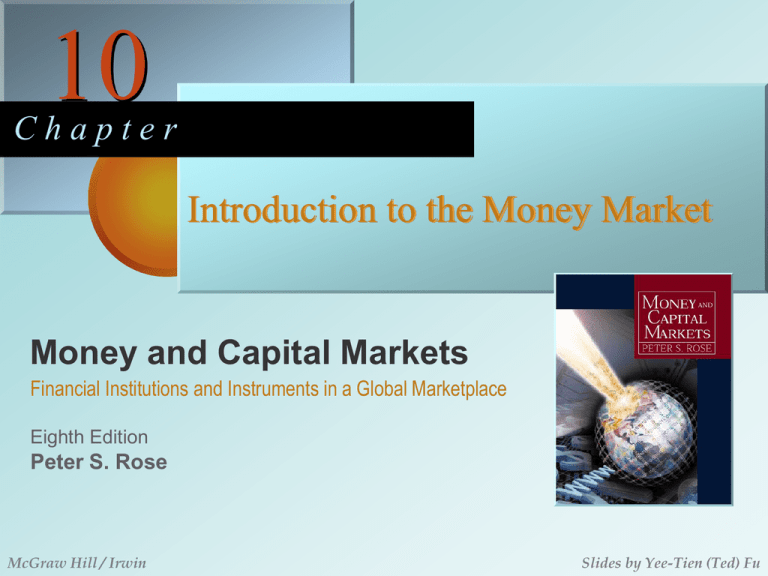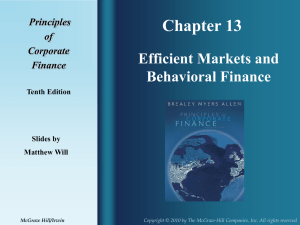
10
Chapter
Introduction to the Money Market
Money and Capital Markets
Financial Institutions and Instruments in a Global Marketplace
Eighth Edition
Peter S. Rose
McGraw Hill / Irwin
Slides by Yee-Tien (Ted) Fu
10 - 2
Learning Objectives
To understand the many roles and functions
performed by the money market.
To identify the key money market players.
To see how money market loans and securities
differ from other financial services and
instruments in the financial system.
To appreciate the importance of speed and
efficiency to money market participants and to
learn how risk is handled.
McGraw Hill / Irwin
2003 by The McGraw-Hill Companies, Inc. All rights reserved.
10 - 3
Introduction
All the transactions carried out in the financial
markets seem to be basically the same:
borrowers issue securities that lenders buy.
However, the different purposes for which
money is borrowed can result in the creation of
different kinds of financial assets having
different maturities, risks, etc.
For instance, the money market is the market
for short-term (one year or less) credit.
McGraw Hill / Irwin
2003 by The McGraw-Hill Companies, Inc. All rights reserved.
10 - 4
Characteristics of the Money Market
The money market is the mechanism through
which holders of temporary cash surpluses
meet holders of temporary cash deficits.
The money market arises because for most
individuals and institutions, cash inflows and
outflows are rarely in perfect harmony with
each other, and the holding of idle surplus cash
is expensive.
McGraw Hill / Irwin
2003 by The McGraw-Hill Companies, Inc. All rights reserved.
10 - 5
Borrowers and Lenders in the Money Market
Government
Treasuries
(borrowing and
redeeming
securities)
Corporate Borrowers
& Cash-Management
Customers Needing to
Invest Cash Surpluses
Security
Dealers &
Brokers
Nonbank
Financial
Institutions
(mutual funds,
insurers, etc.)
Money
Center
Banks
Central Banks
(supplying funds and information
and promoting market stability)
McGraw Hill / Irwin
2003 by The McGraw-Hill Companies, Inc. All rights reserved.
10 - 6
Characteristics of the Money Market
The key money market instruments include:
Treasury bills and short-term government notes
Federal agency notes
Federal funds
CDs and eurocurrency deposits
Discount window loans
Commercial paper and bankers’ acceptances
Financial futures contracts on bills, federal funds,
CDs, Eurodeposits, etc.
McGraw Hill / Irwin
2003 by The McGraw-Hill Companies, Inc. All rights reserved.
10 - 7
Characteristics of the Money Market
Money market investors seek mainly safety
and liquidity, plus the opportunity to earn some
interest income.
Because funds invested in the money market
represent only temporary cash surpluses and
are usually needed in the near future, money
market investors are especially sensitive to
risk.
McGraw Hill / Irwin
2003 by The McGraw-Hill Companies, Inc. All rights reserved.
10 - 8
Types of Investment Risk
Market risk – The risk that the market value of
an asset will decline, resulting in a capital loss
when sold. Also called interest rate risk.
Reinvestment risk – The risk that an investor
will be forced to place earnings from a security
into a lower-yielding investment because
interest rates have fallen.
Default risk – The probability that a borrower
fails to meet one or more promised principal or
interest payments on a security.
McGraw Hill / Irwin
2003 by The McGraw-Hill Companies, Inc. All rights reserved.
10 - 9
Types of Investment Risk
Inflation risk – The risk that increases in the
general price level will reduce the purchasing
power of earnings from the investment.
Currency risk – The risk that adverse
movements in the price of a currency will
reduce the net rate of return from a foreign
investment. Also called exchange rate risk.
Political risk – The probability that changes in
government laws or regulations will reduce the
expected return from an investment.
McGraw Hill / Irwin
2003 by The McGraw-Hill Companies, Inc. All rights reserved.
10 - 10
Characteristics of the Money Market
Original maturities on money market
instruments range from as short as one day on
many loans to banks and security dealers to a
full year on some bank deposits and T-bills.
But because there are so many money market
securities outstanding, some of which reach
maturity each day, investors have a wide menu
of actual maturities from which to make their
selections.
McGraw Hill / Irwin
2003 by The McGraw-Hill Companies, Inc. All rights reserved.
10 - 11
Characteristics of the Money Market
The money market is extremely broad and
deep. It can absorb a large volume of
transactions with only small effects on security
prices and interest rates.
The money market is also very efficient.
Securities dealers, major banks, and funds
brokers maintain constant contact with one
another through a vast telephone and computer
network and are hence alert to any bargains.
McGraw Hill / Irwin
2003 by The McGraw-Hill Companies, Inc. All rights reserved.
10 - 12
Characteristics of the Money Market
Federal funds are mainly deposit balances of
commercial banks held at regional Federal
Reserve banks and at larger correspondent
banks across the U.S.
Federal funds are often called immediatelyavailable funds because of the speed with
which money moves from one bank’s reserve
account to that of another.
McGraw Hill / Irwin
2003 by The McGraw-Hill Companies, Inc. All rights reserved.
10 - 13
Characteristics of the Money Market
In contrast, funds transferred by checks are
known as clearinghouse funds. The
clearinghouse is a location where checks and
other cash items are delivered and passed from
one depository institution to another.
Clearinghouse funds are an acceptable means
of payment for most purposes, but not in the
money market, where speed is of essence.
Clearinghouse funds also have an element of
risk.
McGraw Hill / Irwin
2003 by The McGraw-Hill Companies, Inc. All rights reserved.
10 - 14
Characteristics of the Money Market
The money market is a wholesale market for
funds – most trading occurs in multiples of a
million dollars.
The market is dominated by a relatively small
number of large financial institutions that
account for the bulk of federal funds trading.
Securities also move readily from sellers to
buyers through the market-making activities of
major security dealers and brokers.
McGraw Hill / Irwin
2003 by The McGraw-Hill Companies, Inc. All rights reserved.
10 - 15
Characteristics of the Money Market
And, of course, governments and central banks
around the world play major roles in the
money market as the largest borrowers and as
regulators.
McGraw Hill / Irwin
2003 by The McGraw-Hill Companies, Inc. All rights reserved.
10 - 16
Volume of Selected Money Market Instruments
($ Billions at Year-End)
Financial Instruments
1990
1992
U.S. Treasury bills
$527 $658
Federal agency securities 435
484
Commercial paper
561
549
Bankers’ acceptances
55
38
Federal funds
borrowings & REPOs 409
448
Net Euro$ borrowings
by domestic banks from
their own branches
37
71
Certificates of deposit
($100,000 or more)
432
367
1994
1996
1998
2000
$734 $777 $ 691 $ 647
742
926 1296 1852
595
775 1163 1624
30
26
14
10
482
610
572
618
76
114
152
191
364
413
576
720
2003 by The McGraw-Hill Companies, Inc. All rights reserved.
Data
McGraw
Source:
HillBoard
/ Irwinof Governors of the Federal Reserve System
10 - 17
The Pattern of Money Market Interest Rates
The foundation of the market’s structure is the
level of yields on Treasury bills.
Most other yields in the money market are
scaled upward from Treasury bill rates.
The key price and yield determinants are
safety, liquidity, marketability, and taxability.
McGraw Hill / Irwin
2003 by The McGraw-Hill Companies, Inc. All rights reserved.
10 - 18
The Pattern of Money Market Interest Rates
10 - 19
The Pattern of Money Market Interest Rates
10 - 20
Money and Capital Markets in Cyberspace
As the money market grows in size, it attracts
great attention on the world wide web.
Websites that are related to the money market
include:
http://homepage.swissonline.net/FinCalc/
http://www.enth.com/ask.asp
http://www.economagic.com/fedbog.htm
McGraw Hill / Irwin
2003 by The McGraw-Hill Companies, Inc. All rights reserved.
10 - 21
Chapter Review
Introduction
Characteristics of the Money Market
The Need for a Money Market
Borrowers and Lenders in the Money Market
The Goals of Money Market Investors
Types of Investment Risk
Money Market Maturities
Depth and Breadth of the Money Market
Federal Funds versus Clearinghouse Funds
A Market for Large Borrowers and Lenders
McGraw Hill / Irwin
2003 by The McGraw-Hill Companies, Inc. All rights reserved.
10 - 22
Chapter Review
The Volume of Market Market Securities
The Pattern of Interest Rates in the Money
Market
McGraw Hill / Irwin
2003 by The McGraw-Hill Companies, Inc. All rights reserved.






